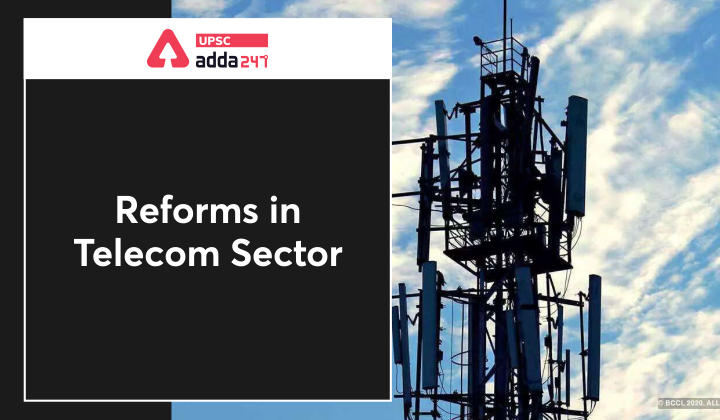Table of Contents
Relevance
- GS 2: Government policies and interventions for development in various sectors.
Context
- The Union Cabinet, has recently approved Nine structural reforms and Five procedural reforms plus relief measures for the Telecom Service Providers.
Key points
Structural reforms
- Rationalization of Adjusted Gross Revenue (AGR): Non-telecom revenue will be excluded from the definition of AGR.
- Bank Guarantees (BGs) rationalized: 80% reduction in BG requirements against License Fee (LF) and other similar Levies. No requirements for multiple BGs in different Licenced Service Areas (LSAs) regions in the country. Instead, One BG will be enough.
- For Auctions held henceforth, no BGs will be required to secure instalment payments. Industry has matured and the past practice of BG is no longer required.
- Interest rates rationalized/ Penalties removed: From 1st October, 2021, Delayed payments of License Fee (LF)/Spectrum Usage Charge (SUC) will attract interest rate of SBI’s MCLR plus 2% instead of MCLR plus 4%; interest compounded annually instead of monthly; penalty and interest on penalty removed.
- Spectrum Tenure: In future auctions, tenure of spectrum increased from 20 to 30 years.
- Surrender of spectrum will be permitted after 10 years for spectrum acquired in the future auctions.
- No Spectrum Usage Charge (SUC) for spectrum acquired in future spectrum auctions.
- Spectrum sharing encouraged– additional SUC of 0.5% for spectrum sharing removed.
- To encourage investment, 100% Foreign Direct Investment (FDI) under automatic route permitted in Telecom Sector. All safeguards will apply.
Data Localisation: Advantages and Challenges
Procedural Reforms
- Auction calendar fixed – Spectrum auctions to be normally held in the last quarter of every financial year.
- Ease of doing business promoted – cumbersome requirement of licenses under 1953 Customs Notification for wireless equipment removed. Replaced with self-declaration.
- Know Your Customers (KYC) reforms: Self-KYC (App based) permitted. E-KYC rate revised to only One Rupee. Shifting from Prepaid to Post-paid and vice-versa will not require fresh KYC.
- Paper Customer Acquisition Forms (CAF) will be replaced by digital storage of data. Nearly 300-400 crore paper CAFs lying in various warehouses of TSPs will not be required. Warehouse audit of CAF will not be required.
- SACFA (Standing Advisory Committee on Radio Frequency Allocation) clearance for telecom towers eased. DOT (Dept. of Telecommunication) will accept data on a portal based on self-declaration basis. Portals of other Agencies (such as Civil Aviation) will be linked with DOT Portal.

Addressing Liquidity requirements of Telecom Service Providers
- Moratorium/Deferment of upto four years in annual payments of dues arising out of the AGR judgement, with however, by protecting the Net Present Value (NPV) of the due amounts being protected.
- Moratorium/Deferment on due payments of spectrum purchased in past auctions (excluding the auction of 2021) for upto four years with NPV protected at the interest rate stipulated in the respective auctions.
- Option to the TSPs to pay the interest amount arising due to the said deferment of payment by way of equity.
FEMA amendment rules, 2021
Expected benefits
- The reforms are expected to
- protect and generate employment opportunities,
- promote healthy competition,
- protect interests of consumers,
- infuse liquidity,
- encourage investment
- and reduce regulatory burden on Telecom Service Providers (TSPs).
- Also, the Reform measures will further boost the proliferation and penetration of broadband and telecom connectivity.
- It will bring ‘Antyodaya’ under inclusive development and bring the marginalized areas into the mainstream and universal broadband.
- The package is also expected to boost 4G proliferation, infuse liquidity and create an enabling environment for investment in 5G networks.



 TSPSC Group 1 Question Paper 2024, Downl...
TSPSC Group 1 Question Paper 2024, Downl...
 TSPSC Group 1 Answer key 2024 Out, Downl...
TSPSC Group 1 Answer key 2024 Out, Downl...
 UPSC Prelims 2024 Question Paper, Downlo...
UPSC Prelims 2024 Question Paper, Downlo...




